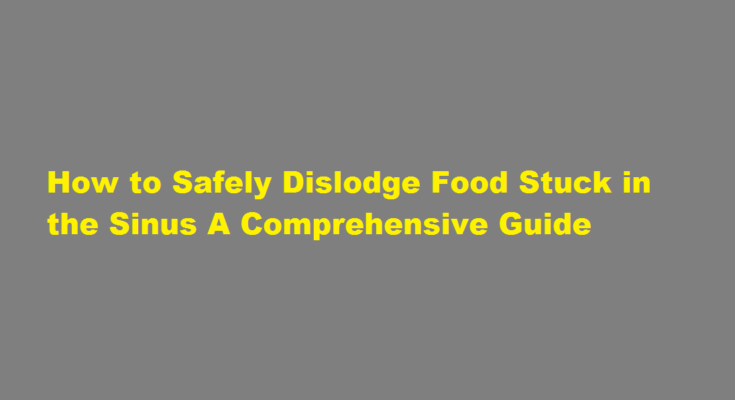Introduction
While uncommon, it is possible for food particles to get lodged in the sinus cavities, causing discomfort and potential health risks. When this happens, it’s crucial to address the issue promptly and safely. This article aims to provide a unique and informative guide on how to dislodge food stuck in the sinus, focusing on non-invasive methods that can be performed at home. However, it’s important to note that if the problem persists or worsens, seeking medical attention is essential to prevent complications.
Understanding the Sinus Cavity
The sinuses are air-filled spaces located in the skull, which are connected to the nasal passages. They serve various functions, such as moistening the air we breathe, producing mucus to trap dust and other particles, and enhancing our vocal resonance. In some instances, due to anatomical variations or health conditions, food particles can become trapped in the sinus cavity, leading to discomfort and potential infection.
Identifying Symptoms of Food Stuck in Sinus
If food becomes lodged in the sinus, you may experience symptoms such as
- Persistent foul breath.
- Nasal congestion and discharge.
- A constant unpleasant taste in the mouth.
- Facial pain and pressure, particularly around the affected sinus.
- Headache.
- Difficulty breathing through the nose.
- Postnasal drip.
Non-Invasive Methods to Dislodge Food
Nasal Irrigation
Nasal irrigation involves flushing out the nasal passages with a saline solution. It can help dislodge the food particle and clear any mucus or debris that might be trapping it. To perform nasal irrigation, use a saline nasal spray or a neti pot filled with a sterile saline solution. Tilt your head to the side and pour the solution into one nostril, allowing it to flow out through the other nostril. Repeat on the other side.
Steam Inhalation
Steam inhalation can help soften the mucus and facilitate the movement of the food particle. Boil water and transfer it to a bowl. Cover your head with a towel and inhale the steam for about 10 minutes. Be cautious not to burn yourself with the hot water or steam.
Nasal Massage
Gently massaging the affected sinus area can encourage the movement of the food particle towards the nasal passage, making it easier to dislodge. Use your fingertips to apply light pressure and circular motions on the affected area.
Gravity Technique
Try lying down with your head hanging slightly off the edge of the bed. Stay in this position for a few minutes, and the force of gravity may help move the food particle out of the sinus.
Over-the-Counter Decongestants
Using over-the-counter decongestant sprays or nasal drops can help reduce swelling in the nasal passages and sinuses. This may aid in the expulsion of the trapped food particle.
When to Seek Medical Attention
If the food particle remains stuck or if you experience severe pain, bleeding, or persistent symptoms, it’s essential to seek medical attention. A healthcare professional can assess your condition and provide appropriate treatment, which may involve endoscopic removal under controlled conditions.
Preventing Food from Getting Stuck in the Sinus
Prevention is always better than cure. To minimize the risk of food becoming trapped in the sinus, follow these preventive measures
- Eat mindfully and avoid talking or laughing while eating, especially with a mouthful of food.
- Chew food thoroughly before swallowing to reduce the chances of larger particles getting lodged in the sinus.
- Stay hydrated to maintain optimal mucus production and nasal function.
- Manage allergies and respiratory conditions that can lead to nasal congestion.
Frequently Asked Questions
Can food get stuck in your nasal cavity?
Only the imagination limits the objects and circumstances that result in things getting stuck inside of the nose. Common objects found in noses include food material, tissue paper, beads, toys, and rocks.
Why does it feel like something is stuck in my sinus?
With all exits to your nose and throat mostly or completely blocked, mucus becomes stuck in your sinuses, giving you a feeling of stuffiness and pressure that can be downright miserable.
Conclusion
While dislodging food stuck in the sinus can often be done through non-invasive methods at home, it’s essential to approach the process with caution and consult a medical professional if symptoms persist or worsen. Proper preventive measures can also help reduce the risk of food particles becoming trapped in the sinus in the first place. Remember that your health is a priority, and seeking medical advice when needed is crucial to ensure your well-being.
Read Also : Clearing The Airways A Guide to Dislodging Phlegm for Better Breathing



